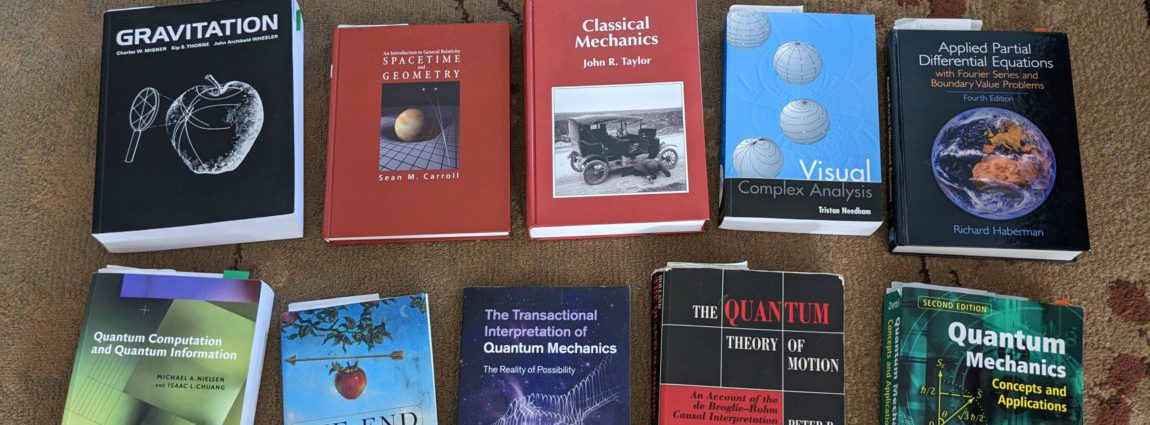Quantum Information
The quantum information (QI) meetings will be “relatively” simple mathematically, requiring only the material covered in the “Notes” and in preceding QI lectures.
- The Basics (including Teleportation and Superdense Coding)
Covered in many meetings over the last year
References: The “Old Notes” and SD_Coding.pdf - Review of Dirac Notation
Done at the 14 Jan 2018 Kickoff Meeting
Reference: The “New Notes” pages 2-3.
- Measurements in the Bell Basis
- Part I (Mike did this on March 4th)
– Active vs passive transformations
– “True” change of basis vs linear combination
– An operator that takes the Bell basis to the classical basis - Part II (March 11th)
We’ll revisit Quantum Teleportation and Superdense Coding, this time from the perspective of “measurments in the Bell Basis” which is how these algorithms are often described in textbooks. - References:
Old Notes page 62.
SD_Coding.pdf and Nielsen and Chuang (page 97).
- Part I (Mike did this on March 4th)
- Pure and Mixed States
The distinction between “pure” and “mixed” states is a fundamental concept which needs to be understood in order to make sense of the Density Matrix and various measures of entanglement. Also, a simple thought experiment based on this concept sheds some insight into the “reality” of quantum superpositions.
Tina did this at the January 28th meeting
Reference: The “New Notes” pages 4-5. - Introduction to the Density Matrix
Tina did this at the January 28th meeting and then again on June 10th
Reference: The “New Notes” starting on page 6. - The Partial Trace operation
Tina Did this on June 17th - Measuring Entanglement with the Density Matrix
Tina Did this on June 17th - Grover’s Algorithm
- Reference: Emma Strubell’s Notes – Starting on page 20.
- [Feb 11th] Background and Overview
- [Feb 11th] The Flagger (or “Oracle”)
- [Feb 18th] The Diffusion transform: how/why does it work?
- [Feb 25th] Is this really a “search” algorithm?
- Simon’s Algorithm
(TBD) - The “Bloch sphere”
Mike did this on June 24th and July 1st. - (TBD) The Mach-Zehnder interferometer and its relationship to
quantum circuits - Shor’s Algorithm
This is certainly the best known and most important quantum computing algorithm. We’ll undoubtedly spend several sessions on it.We covered this over several sessions in late 2018.
Here are some (unfortunately imcomplete) notes: Shor.pdf
Quantum Mechanics
The quantum mechanics (QM) meetings will be much more advanced mathematically than the QI meetings, and will require at least some understanding of typical undergraduate “applied math” such as calculus, differential equations, and so on.
- Basic facts about the Schrödinger equation
Mike did this at the 21 January 2018 QM#1 Meeting
References: Any quantum mechanics textbook. - [May 13] Mike: The transition from discrete to continuous vector spaces
References: (1) Notes (2) Summary Chart - [May 27] Matt: The Uncertainty Principle, Part I
- Some basic solutions to the Schrödinger equation
- [Stefan April 22] Infinite Well
- Free Particle
- Finite Step
- Delta Function
- Finite Well
- Review of the Classical Oscillator
- Harmonic Oscillator
- (1st introduction to) Interpretations of Quantum Theory
- (TBD) The “textbook” interpretation
- (TBD) Problems:
– The ontological status of the quantum state
– The measurement problem
– The “locality” debate - Interpretations
– (TBD) The “no interpretation” interpretation
– (TBD) Everett
– (TBD) Pilot Wave (de Broglie / Bohm)
– (TBD) Transactional
– (TBD) Others
Weird quantum scenarios
- (TBD) The Zeno and Inverse Zeno effects
- [March 18] Jonathan: The Delayed Choice experiment
- [June 3] Jonathan The Elitzur-Vaidman bomb tester
References: Jonathan’s PowerPoint Notes - [June 3] Jonathan The Elitzur-Vaidman bomb tester
- (TBD) Weak Measurments
- (TBD) Non-demolition Measurements
- (TBD) The Double Slit experiment
Special Relativity
(TBD)
General Relativity
(TBD)
Quantum Aspects of Life
- 28 May 2017: Jonathan did Quantum Photosynthesis
– References: photosynthesis.pptx - Also, see: resources/quantum-aspects-of-life
Time
Time, in quaaludes and red wine
Demanding Billy Dolls
And other friends of mine …
- (TBD) What exactly is the problem?
- (TBD) Special Relativity: Time isn’t what it used to be.
- (TBD) Statistical Mechanics: Boltzmann, Gibbs, and initial conditions.
- Jonathan: Can time emerge from a stationary quantum state?
